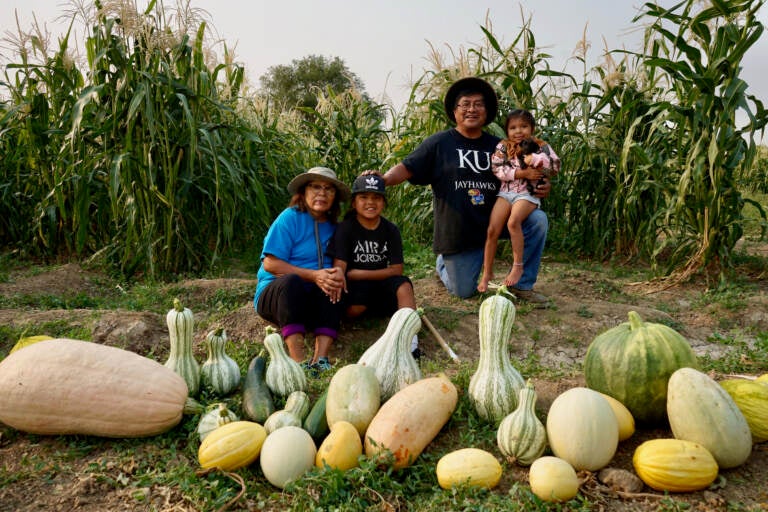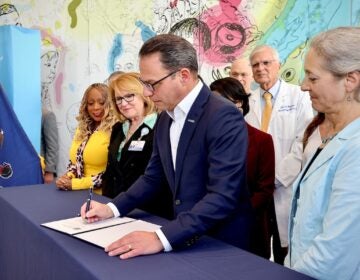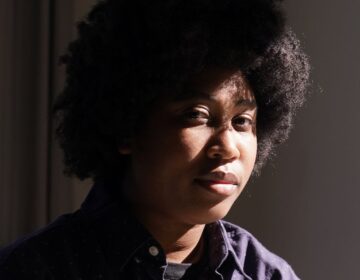Hit hard by COVID, Native Americans come together to protect families and elders

Native tribes have responded to the pandemic with creative ways to stay connected. Veronica Concho and Raymond Concho Jr. grew traditional Pueblo foods and Navajo crops with their grandchildren Kaleb and Kateri Allison-Burbank in Waterflow, N.M. (Joshuaa Allison-Burbank/NPR)
The past year and a half have been stressful on many fronts for Chris Aragon, a caregiver for his older brother who has cerebral palsy.
“The left side of his body is atrophied and smaller than his right side, and he has trouble getting around. He’s kind of like a big teenager,” says Aragon, 60, who is part Apache and lives with his brother on the Fort Berthold Reservation of the Mandan, Hidatsa and Arikara Nation, in North Dakota.
His main goal throughout the pandemic has been to keep his brother safe from COVID-19, and “it’s really been a struggle,” he says.
The pandemic has been a financial stressor, too, says Aragon. He worked reduced hours last year, and had periods with no work recently. “I’d wake up at night to go to the restroom, and then I wouldn’t be able to go back to sleep.”
Aragon is among the 74% of American Indian and Alaska Natives who said someone in their household has struggled with depression, anxiety, stress and problems with sleeping, in a recent poll by NPR, the Robert Wood Johnson Foundation and the Harvard T.H. Chan School of Public Health. Only 52% of white people said the same.
COVID exacerbated long standing stresses created by historic inequities, says Spero Manson, who’s Pembina Chippewa from North Dakota, and directs the University of Colorado’s Centers for American Indian and Alaska Native Health.
Native communities in the United States have had higher rates of infection, are 3.3 times more likely to be hospitalized and more than twice as likely to die from the disease than whites. And half of Native Americans in NPR’s poll said they’re facing serious financial problems.
“As we struggle to address the sudden and precipitous added stresses posed by the hour by the pandemic, it heightens that sense of pain, suffering of helplessness and hopelessness,” says Manson. And it’s manifesting in higher rates of anxiety, depression, post-traumatic stress disorder, he adds.
“I think the pandemic has definitely triggered this historical trauma that Native people do experience,” says Adrianne Maddux, the executive director at Denver Indian Health and Family Services, which runs a primary care clinic.
She’s witnessed a higher demand for behavioral health services, including addiction treatment. “Our therapists were inundated,” says Maddux.
Responding to collective grief with collective support
But native communities also have unique strengths that have helped them approach the COVID crisis with resilience, says Manson. Tribes have responded to the pandemic with new initiatives to stay connected and support one another.
“American and Alaska Native people, we are very social and collective in our understanding of who we are, how we reaffirm this sense of personhood and self,” says Manson. “Some of the strength and resilience is in how collective and social these communities are.”
Part of the struggle in the pandemic has been “having a limited ability to get together and gather for things like powwows and ceremonies and other events that really keep us connected,” says Victoria O’Keefe, a member of the Cherokee and Seminole Nations, and a psychologist at the Center for American Indian Health at Johns Hopkins University. And she adds, there’s “collective grief, especially grief around losing elders and cultural keepers.”
But that collective mindset has also brought people together to heal. “We really see so many communities mobilizing and are really determined to protect each other,” says O’Keefe. “This is driven by shared values across tribes such as connectedness, and living in relation to each other, living in relation to all living beings and our lands. And we protect our families, our communities, our elders, our cultural keepers.”
That was evident in the Navajo Nation, says O’Keefe’s colleague, Joshuaa Allison-Burbank, a member of the Navajo Nation and a speech language pathologist at the Center for American Indian Health.
“This concept of Navajo of K’é,” he says. “It means family kinship ties.”
Allison-Burbank spent the early months of the pandemic working on the frontlines at a COVID care clinic of the Indian Health Services in Shiprock, N.M. He says people were quick to start masking and social distancing.
“That’s what was so important for getting a grasp and controlling viral spread across the Navajo Nation was going back to this concept with respect to other humans, respect to elders,” says Allison-Burbank. “It’s also the concept of taking care of one another, taking care of the land.”
It also helped communities find creative solutions to other pandemic-related crises, like food shortages, he adds.
Many people, including his own family, started farming and cooking traditional crops like corn and squash, which they previously ate only during traditional ceremonies.
“My whole family, we were able to farm traditional Pueblo Foods and Navajo crops,” says Allison-Burbank. “And not just have enough for ourselves, but we had an abundance of to share with our extended family, our neighbors and to contribute to various mutual aid organizations.”
He says farming also allowed community members to spend more time together safely — which helped buffer some of the stress.
Helping kids and elders navigate COVID fears
Families also had more time to speak their native language and practice certain cultural routines, which he thinks helped people emotionally.
Allison-Burbank, O’Keefe and their colleagues at the Center for American Indian Health also spearheaded an effort to help American Indian and Alaska Native children cope during the pandemic. They wrote, published and distributed a children’s story book called Our Smallest Warriors, Our Strongest Medicine: Overcoming COVID-19.
The book, which was illustrated by a native youth artist, tells the story of two kids whose mother is a health care worker treating people with COVID-19. So, the kids turn to their grandmother, who helps them navigate their fears and anxieties.
“Storytelling is an important and long standing tradition for tribal communities,” says O’Keefe. “And we found that this was a way that we could weave together our shared cultural values across tribes, as well as public health guidance and mental health coping strategies to help native children and families.”
Over 70,000 copies of the book have been distributed across 100 tribes, says O’Keefe. In addition to the book, parent resources and children’s activities are available for free on the center’s website.
On the Berthold Reservation, where Aragon lives, he says tribal leaders were “very proactive” about supporting people with COVID-19 and their families. “All [people] had to do was pick up the phone and call to get extra help, or get groceries brought to their house,” he says.
Authorities also helped individuals with COVID-19 isolate, using cabins at a local campground, so that they could minimize the risk of exposing other family members, he says.
And people took the time to help the elderly, he adds. “They definitely treat their elders well here, and they’re not just forgotten and put in a nursing home somewhere.”
Tribal youth in Minneapolis had similar efforts to take care of elders in their community, assisting them with getting food, medicine and other tasks, says Manson.
“This reflects an enormous sense of importance of elders in our communities as the repositories of cultural knowledge and our spiritual leaders,” he says, as well as the importance of intergenerational relationships.
Reaching across tribal boundaries
The Oneida Indian Nation, which is located in upstate New York, recently unveiled an art installation to increase awareness about the disproportionate impact of the pandemic on Native communities as well as resources around COVID-19. Titled Passage of Peace, the installation features large tipis, which are traditional homes and gathering places.
The installation is located just off of the New York State Thruway, about midway between Syracuse and Utica. “We hope the Passage of Peace will bring attention to continued hardship taking place in many parts of Indian country, while delivering a message of peace and remembrance with our neighboring communities here in Upstate New York,” says Ray Halbritter, Oneida Indian Nation Representative.
Native communities are also connecting and supporting each other online, with projects like the Social Distance Powwow Facebook group, founded in March 2020 to “foster a space for community and cultural preservation.” People from many different tribes share songs, dance videos, conversations, stories, and fundraisers and sell arts and crafts. It now has over 278,000 members.
The sense of community and respect for elders were also behind American Indian and Alaska Native people being more willing to get vaccinated to protect their communities, says Jennifer Wolf, founder of Project Mosaic, a consulting group for indigenous communities.
“We have so many reasons to be mistrustful of a government that has taken land away from us and broken so many promises,” says Wolf, “and yet we have the highest (Covid-19) vaccination rates in the country.”
According to the U.S. Centers for Disease Control and Prevention, half of all American Indian and Alaska Native people have been fully vaccinated, and 60% have received at least one dose, as compared to only 42% and 47% respectively of all whites.
9(MDAzMzI1ODY3MDEyMzkzOTE3NjIxNDg3MQ001))




